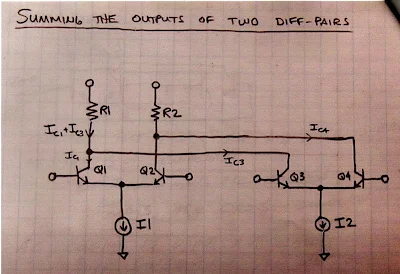SolderSmoke Podcast #253 is available: http://soldersmoke.com/soldersmoke253.mp3
October 16, 2024
Sponsor! Parts Candy is back! Handmade in Chicago! Standard test leads, Hook clips, alligator clips in 12" and 32" and multimeter leads
Travelouge/Intro
Bill's trip to NYC -- The Empire State Building
Dean goes to the Bay area.
Harry Caul, Marty Klein W3VCG , "The Conversation" and THE KNACK.https://soldersmoke.blogspot.com/2024/08/harry-caul-had-knack-movie-review.html
Joe Piscopo in Bell System video! https://soldersmoke.blogspot.com/2024/08/soldersmoke-quiz-question-who-is-actor.html
Bill's Bench
Bill's report from SolderSmoke Shack South: The tropics: What this means. Guapo wouldn't go out when the sun was overhead.
Skies not great for astronomy now. But we see a lot of satellites, and meteors.
Antenna developments: 1/4 vertical on a fishing pole.
Lightning suppression coming for the building. Lightning suppressors. Got 2. Good video from the IMSAI guy: https://www.youtube.com/watch?v=7EyABPuNDMA Argon gas suppresion tubes.Need to crimp!
Hurricane prevention. Metal storm curtains.
Thinking of solar panels. 12 panels, 5 kW system. Probably without batteries. What do you think?
A golf cart.
New PC. BeeLink. Very tiny! (palm of your hand) 24 inch screen. Works well https://www.amazon.com/dp/B0BVFKN7ZL?ref=ppx_yo2ov_dt_b_fed_asin_title&th=1
A very satisfying fix on the 15/10 rig -- loose connection to RF amp. The highly suspect Ramsey Kit Amp was NOT the culprit! Got to use the new Rigol DS-1102. A fun fix. Will build a second CCI amp.
Digital Selective Calling -- listening to ships and shore stations on HF. https://soldersmoke.blogspot.com/2024/10/monitoring-maritime-radio-messages-with.html
SHAMELESS COMMERCE: Our blogs and the podcast are in danger! Pete is already on a permanent blog hiatus. I have seen a big decline in readership. Frankly, if no one is reading or listening, we just may decide not to do it anymore. We don't want to do this. So please, link to the blogs. Talk up the blog and podcast on your own blogs and social media.
Parts Candy Test Leads are back as our sponsor. Pete has them. Dean has them, I have them in two different countries! DON'T SCRIMP WITH A CRIMP!
SPRAT Summer 2O24 Special EXTRA 50th Anniversary issue! https://www.gqrp.com/sales.htm
Dean's Bench
First CW contact: With KK4DAS on his HB sBITX and Alan W2AEW POTA. TRGHS.
Dean fixes the sBITX problems. Again. SUB-THRESHOLD CONDUCTION! Lots of patience and stick-to-it-ivness. LPF leakage! https://kk4das.blogspot.com/2024/08/homebrew-sbitx-lpf-leak-stopped.html
IMD IMD IMD and the Tiny SA Ultra https://soldersmoke.blogspot.com/2024/09/sherwood-its-time-to-clean-up-our.html
AI AI AI -- Experimental AI Podcasts about SolderSmoke (no kidding -- (NOT April 1) Where they came from https://soldersmoke.blogspot.com/2024/09/where-ai-podcasts-came-from.html
AI Podcast #2 https://soldersmoke.blogspot.com/2024/09/here-is-another-short-podcast-about.html
AI Podcast #1 https://soldersmoke.blogspot.com/2024/09/a-new-experimental-podcast-about.html
Pete's Bench
An all PNP rig -- A notional look, https://n6qw.blogspot.com/2024/08/august-30-2024-pnp-20m-ssb-transceiver.html
Videos on old Boatanchors. https://www.youtube.com/watch?v=mnboJ75NCmY&t=1s
MAILBAG:
Lex PH2LB making some new stickers. Look out San Francisco!
Rogier PA1ZZ sending lots of good ideas and links.
Todd K7TFC great idea on SS readersip decline
Todd VE7BPO aka Vasily -- great info on how to stabilize LC oscillators. https://soldersmoke.blogspot.com/2024/09/qrp-homebuilder-shows-us-how-to-build.html
Eric 4Z1UG Welcome words of encouragement on the blog and podcast
Dave W2DAB says that AI just can't replace the Tappit Brothers of ham radio. Now the Tappit Triplets.
Michael AA1TJ Thoughtfully skeptical about AI.
Grayson K7JUM on the cleanliness of the 32S-3. Also amazing video on Thermatron MMM.
Mike WN2A working on DC receivers and hum!
Floran OE7FTI building Farhan's JBOT amp!
Mike Murphy WU2D building 1930 replica rigs using a Frank Jones circuit
Dave K8WPE always great to hear from such a strong SolderSmoke supporter.
Walter KA4KXX Great ideas from the Wizard of Orlando.
Paul G0OER -- Reacting to the 1970s Ham Radio video. Didn't remember being so cool.
Thomas K4SWL -- Struggling with the hurricane in NC. Hang in there OM.
Nick M0NTZ building another Direct Conversion receiver -- with videos about it.
Michael AG5VG building a Mythbustrer-style 20 meter rig. FT-101 VFO. FB
Tony G4WIF -- Readership problem advice
John AB2XT sent us 6000 47 pf NP0 capacitors. So we are now good for caps! Thanks John.
Paul VK3HN Was suitably impresses by the AI podcasts we put on the blog. Thanks Paul.






.jpg)







.png)











